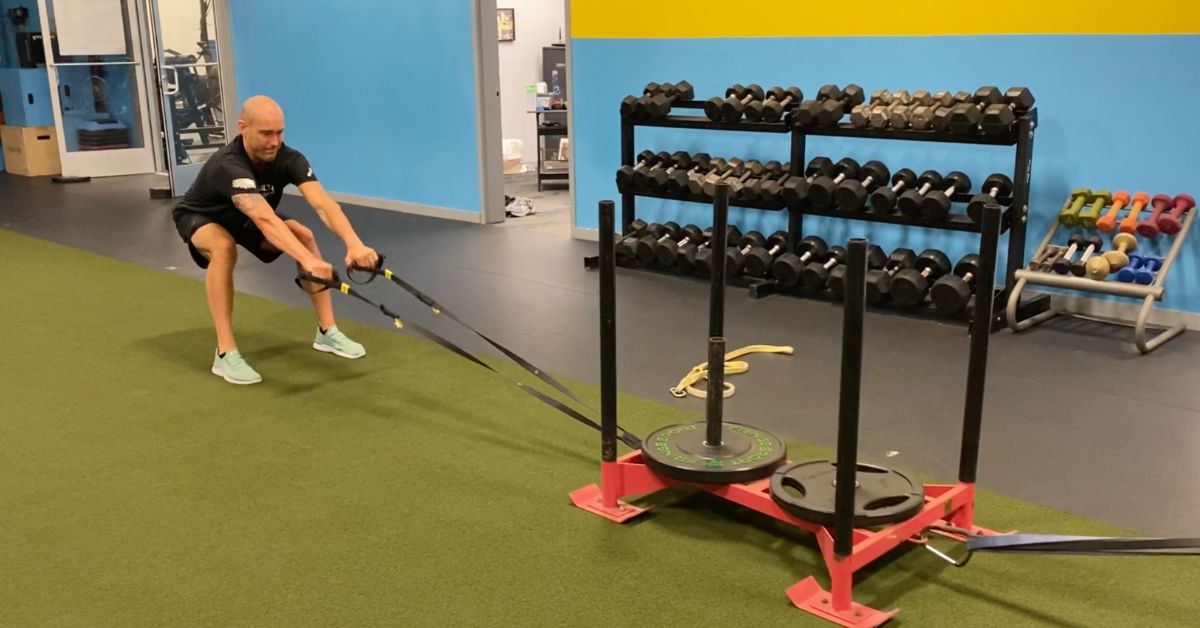We all know how this goes…you go through your twenties loving life, working out whenever you want and still seeing results even if you were out playing beer pong until 2am the night before. No worries—just chug a protein shake, then sweat it out while watching your veins pop.
This high-flying stage of life has its benefits, but it’s not a long-term reality. In fact, those habits are why many men get stuck when it comes to losing weight and staying fit to compete in adult leagues or Masters competitions in their late thirties, forties, and beyond.
You see, your body goes through cellular aging, and this takes a toll on the amount of macrophages to clean up, repair, and recycle bad cells to keep immunity strong and your body recovering at rates higher than the two burglars in Home Alone.
If you also get married, have kids, and work at a stressful job…this all creates more havoc on your system. Most guys revert back to their “traditional” methods, which is like watching the Steelers still try to dominate the run game because that was their Old School mentality, yet the new ages have yet to show them that they have no offensive line to make it work.
Since your methods of getting lean and jacked just won’t work like they used to, here are some suggestions for staying conditioned to compete even as you get older.
Conditioning Methods for the Athlete Over 35
First, let’s recap a few types of cardio you have available.
Cardiac Output Method
Guidelines:
- 30-60 minutes of steady-state conditioning.
- Heart-rate 60-70% for the duration (or using the Maffetone Method (MAF) of ‘180 minus your age’ for more aerobically trained individuals).
- Exercise Selection: Cyclical
- Sample Programming—EMOM 40:
-
- Minute 1: 45s Easy run
-
- Minute 2: 45s Air Bike
-
- Minute 3: 45s Jump Rope
-
- Minute 4: 45s Med Ball Slams
[vimeo 1075507565 w=800]
Video 1. Air Bike sprint as part of cardiac output method.
Mixed Modality Conditioning
Guidelines:
- 20-30 Minutes Conditioning
- Heart-rate 70-80% of max
- Exercise Selection: Cyclical & Kettlebell Complexes
- Work/Rest: 1:1 – 1:3
- Sample Programming—5 Rounds of:
-
- KB/DB Complex of: 5 Double KB Swings + 5 Double KB Cleans + 5 DB KB Thrusters
-
- Ski Erg x 12 Calories
-
- Rest 2:00 or until HR comes down to 110
[vimeo 1075508430 w=800]
Video 2. Kettlebell complex in mixed modality conditioning.
High-Intensity Intervals
High-Intensity Intervals aim to use a variety of sustainable exercises with incomplete bouts of rest after each round. The intent is to stimulate higher oxygen utilization and improve the aerobic abilities of fast-twitch fibers.
High-Intensity Intervals aim to use a variety of sustainable exercises with incomplete bouts of rest after each round. The intent is to stimulate higher oxygen utilization and improve the aerobic abilities of fast-twitch fibers. Share on XNotice, I used the word sustainable. So when we think about movements that can be sustained for longer durations, we are not thinking about using locally demanding movements like a push-up or pull-ups that have high rates of peripheral fatigue. Most trainees will be limited by local muscle endurance, not their overall level of aerobic conditioning.
When we select movements, they need to be movements you could sustain for 30-60 seconds without stopping.
Guidelines:
- Low resistance movements that can be sustained for the entire interval without stopping.
- 15-20 minutes in total duration.
- Incomplete rest intervals.
- 1-2 sessions per week.
- Sample Programming—5 Rounds of:
-
- Air Bike for Calories x 60s
-
- Russian KB Swings x 60s
-
- Rowing for Calories x 60s
-
- Box step-ups (unweighted) x 60s
-
- Rest x 60s
This anaerobic systems work is for adult athletes who struggle to maintain a high level of output in the 60-90 second range—this work is the ability to sustain anaerobic energy production for extended periods of time.
[vimeo 1075508497 w=800]
Video 3. Ski Erg sprint performed in high intensity intervals.
[vimeo 1075508549 w=800]
Video 4. High intensity interval of kettlebell swings.
Glycolytic Capacity Work
This type stimulates an increase in buffering mechanism involved with allowing anaerobic glycolysis to continue. This work also increases glucose storage and utilization potential. A wide variety of exercises can be used, from sprints to plyometrics, but I tend to favor global patterns such as running, thruster, and burpees (if they can be done safely).
Guidelines:
- Each set is 60-120 seconds.
- 2-5 sets with incomplete rest intervals, 1-2 mins.
- Goal should be complete fatigue.
- Sample programming—Every 4:00 x 5-6 sets:
-
- 3 Sandbag Cleans
-
- 9 Calorie Air Bike
-
- 12 No Push-up Burpees
-
- *Sets should NOT last longer than 2:00, otherwise volume prescriptions will need to be tailored.
[vimeo 1075508588 w=800]
Video 5. Sandbag cleans in circuit.
I also like doing work tires or sleds here.
[vimeo 1075508653 w=800]
Video 6. Work tire flips for glycolytic capacity work.
Know Your Health Profile
Now that we know the cardio types you can pick from, the key is implementing the right ones at the right times!
Let’s talk about what NOT to do first, since I see this more often. The average guy wanting to get into shape will inevitably clear time, get motivated with David Goggins, and then head to the gym to do things like 75 HARD, P90X or other high intensity interval-based workouts, adding in some basic strength exercises on machines.
If the guy is a beginner, he might also hop on the elliptical for 40 minutes then do some machines for strength for 20 minutes.
Now, I am one for saving time in the gym, so I am not here to say combining strength and cardio is wrong. But, you have to be strategic about it and also remember how you can use both in one type of workout, not having to dissociate cardio from strength.
However, your first order of operation must include you taking a good, in-depth look at your health profile.
Things to check:
- Lipids
- Stress
- Sleep
- Glucose
- Free Testosterone
- Free T4/T3 and Reverse T3
- SHBG
- LH and FSH
- Estrogen
- Cortisol
- CRP
- Vitamin D
- Iron
Now, you don’t need to be perfect across the board—and being down in some of these won’t “hurt” your conditioning efforts like some may claim—but trying to train hard and get results with high stress levels is like pouring gasoline on fire.
You can’t expect a car to run empty, and while you can’t gain weight in a deficit, your body will hate you and feel like you should give up nearly every day trying to fight a fitness or fat-loss battle with your health not where it needs to be.
You can’t expect a car to run empty, and while you can’t gain weight in a deficit, your body will hate you and feel like you should give up nearly every day trying to fight a fitness battle with your health not where it needs to be. Share on XIssues from depression to mood swings to poor sleep to gut issues and food intolerances can unfold, which can lead to more issues with hormones…and this all affects metabolic rate and your ability to recover.
Nothing there sounds good, so I would first cross off your health markers.
Training Blocks and Programming
From there, it’s a matter of setting a lifting routine based on your goals. I like focusing on “blocks” of training where I have:
- Endurance Phase (higher reps, shorter rests, circuits, and nothing to failure.)
- Hypertrophy Phase (8-10 reps, pushing to failure, longer rests and exercises with more stability.)
- Max Strength Phase (3-5 reps, more sets and more compound lifts with accessory lifts to fill gaps.)
- Power Phase (3-8 reps, lifting FAST and explosive, shorter reps, multiple sets, and aiming for peak intensity.)
- Athlete Phase (Here, I do more plyometrics, coordination, stability, stamina, and power or add some glycolytic capacity work.)
- REST and REPAIR (yes, key after 35 is to focus on adding these in so you can still get your body to rebalance, repair, and grow. These don’t need to be as long as the actual lifting phases.)
Now that we have blocks, you can work your lifting days into a scheme that works for you. Some options include:
- Push/Pull/Legs
- Upper/Lower
- Full Body
I like these three for most men between 35-55. There is no need for body part splits and your goals should match. As for your lifting days, it’s quite simple: spend 30-45 minutes on your strength work 3-4 days a week, totaling 2-2.5 hours.
Next, fill in the gaps with your cardio and treat it as your side dish. For example, you lift full body workouts and do Monday, Wednesday, and Friday. Then, Tuesday you can do a more cardiac output method for your day one cardio, then a more high intensity interval for day two.
I would use this in either the endurance phase or power or athlete, but not so much in hypertrophy and max strength.
[vimeo 1075508769 w=800]
Video 7. Stationary sled training in conditioning programming.
Saturday? Take the day off and try to mix in some stress-relieving parasympathetic work. Sunday plan a RUCK hike or GPP (general preparedness work like carries and sleds or mixed modality).
Using this general outline, the total comes to 3-4 hours of training per week, provided your cardio is 30 minutes or less. This is much more sustainable and something you can be consistent with vs. body split days of 90-minute workouts doing straight sets.
If I have guys who can ONLY work out a total of 3 days, then we will go full body routes and incorporate cardio into their training days as metabolic finishers. The other option is to just have a block of 2 months strength then 1 month cardio, and then repeat.
Either way you slice it, as long as you’re consistent and it works for you, this plan will help generate results. For the majority of guys I train, they feel less empowered when heading to the gym to walk the treadmill or watching the cooking channel while doing the elliptical. To me, that’s more masculine-energy draining, so I tend to use my gym-time cardio for efforts that elicit the benefit of toughness plus eliminate boredom!
As long as you follow the principles I’ve outlined in this video, you will see how cardio work should not be avoided, but used more as a “side dish” to the entree of your weight training.

Whatever route you choose, remember that your best way to make progress is through smart recovery. If you focus on healing your body, the results will be better and your cardio sessions become easier—and then, a way to even facilitate that recovery.






